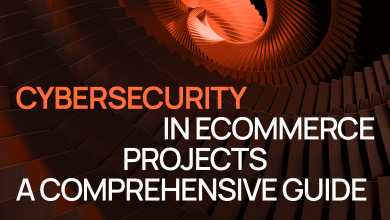Good news: robots haven't taken over the world yet.
Bad news: if you still haven't implemented artificial intelligence in your project, you risk losing the competitive race in 2024.
We're here to explain where the winds are blowing. How participants in the eCommerce market can stay afloat and which key Online Shopping Trends will lead you to success.
In short:
- Artificial Intelligence (AI) and Machine Learning (ML) have already fundamentally transformed the way how businesses interact with consumers.
- Augmented Reality (AR) and Virtual Reality (VR) are opening new horizons for interacting with products, changing the format of “try-ons” and decision-making.
- Blockchain, the technology behind cryptocurrencies, ensures transaction security, supply chain transparency, and enables the creation of unique digital assets— - NFTs. It is especially relevant in the B2C ECommerce Development niche.
Now, let's dive a bit deeper into each point. We’ll complement the brief facts with interesting statistics and practical solutions.
The impact of AI personalization continues to grow
76% of customers admitted they would prefer a brand that enhances their user experience through AI. How can we implement their preferences in practice?
- personalized recommendations: display additional product pages that might interest the user, based on their purchase and browsing history.
- individualized advertising offers: create campaigns tailored to the preferences of specific users.
- improved search results: show the most relevant items in search results.
Customers increasingly want a more engaging, simple, and efficient process. Sometimes, they need an AI assistant that can make decisions based on their preferences and past purchases. This drives companies to use artificial intelligence not only for creating images and content but also for more complex business tasks. For example, predicting behavior and creating a highly personalized and automated experience.
By the way, we have a Case Study of the development of an eCommerce project with artificial intelligence, take a look:
"Over the past year, the number of companies approaching us with requests to implement AI technologies has increased by about 65%. This includes chatbots, smart recommendations, and data analysis for optimizing business processes and marketing campaigns. On average, business revenue increases by 10-15% after implementing AI-driven personalization, but in some cases, even significantly more." (с) IT Sales Manager Wezom
AR shopping is becoming the norm in retail
AR helps solve one of the major pain points for eCommerce retailers—frequent and unjustified returns. Back in 2022, a survey by Snap/Publicis Media revealed that 66% of users were less likely to return purchases made using AR technology. Additionally, 80% of respondents admitted that they felt more confident in their actions and decisions when using AR shopping features.
In 2024, AR technologies have become even more accessible and widespread, thanks to augmented reality platforms for mobile devices (Apple's ARKit/Google's ARCore), mixed reality devices like Microsoft HoloLens, and simplified development processes with Unity.
You can implement AR technologies into your eCommerce business in the following ways:
- Virtual fitting rooms;
- Creation of interactive 3D models;
- AR games for promoting new products and marketing tasks;
- AR assembly and usage instructions, etc.
E-commerce industry trends indicate that integrating AR not only boosts customer engagement but also reduces return rates and alleviates pressure on the sales department. And, of course, it serves as a powerful tool for increasing conversion rates.
Blockchain technologies for efficiency and security
Alibaba uses blockchain to track supply chains and combat counterfeiting. Walmart employs it to monitor food expiration dates. Overstock and Shopify use it for accepting payments and expanding their audience to users who prefer this payment method.
Other significant applications of blockchain in eCommerce include:
- protecting customer data and preventing fraud through the decentralized nature of transactions and encryption technologies;
- reducing operational costs (for example, through smart contracts that ensure automatic fulfillment of conditions upon specific events, bypassing banks and notaries);
- creating loyalty programs where rewards and bonuses are stored as tokens;
- optimizing logistics operations, and more.
Blockchain is undoubtedly one of the most promising eCommerce trends for 2024. Although it remains expensive, lacks unified standards, and faces regulatory challenges, we anticipate that 2024 and the coming years will see many innovative solutions emerging based on this technology.
TOP 5 Non-Obvious eCommerce Trends
Everything we discussed above is well-known. The press and news portals frequently cover topics like "New VR showroom opens" or "Company X launches a virtual assistant." However, there are other online retail market trends known only to top market players and industry analysts.
The Mobile Revolution
Adapting websites for mobile devices is certainly important, but it’s not enough. Analysts forecast that by 2028, more than half of all online purchases (specifically, 63 %) will be made through smartphones.

Therefore, retailers need to provide an experience specifically designed for mobile platforms, rather than just adapted from desktop.
Developing a branded app is not a trend in
For example:
- Virtual stylists and AR models, as mentioned earlier.
- Gamification.
- Voice control, and more.

Omnichannel Experiences
Customers are increasingly blending their online and offline experiences. Specifically, this includes strategies like BOPIS (Buy Online, Pay In-Store) and ROPO (Research Online, Purchase Offline).
Maintaining up-to-date information on product availability and prices in both online and offline systems requires reliable IT solutions and real-time database synchronization. Additionally, improvements in logistics, process optimization, and staff training are necessary.
Only retailers who provide a flawless, seamless experience will stay ahead. According to statistics, companies with multichannel engagement see, on average, 179% higher revenue compared to those that do not implement similar strategies. To achieve this, it is essential to invest in creating a unified ecosystem and a comprehensive digital platform.
Headless commerce
This is the architecture of
The benefits are clear:
- the ability to create more personalized and user-friendly interfaces for different devices;
- rapid development and implementation of new features;
- the capability to experiment with various technologies and designs.
We recommend considering headless commerce if you need a high degree of flexibility and customization, as well as if you plan to develop a multichannel sales strategy. For more details, you can always consult with our manager during a free consultation.
Zero-click
At the end of 2023, Google introduced the Search Generative Experience (SGE). While it may seem like just a feature to enhance user experience in search, it actually has significant implications for current trends in
In reality, it's a strong signal that it’s time to focus on optimizing content and securing a spot in the new search results. This involves integrating voice search into your ecosystems to appear in recommendations and adapting your web resources to changing conditions.
Omnichannel Experiences
Customers are increasingly blending their online and offline experiences. Specifically, this includes strategies like BOPIS (Buy Online, Pay In-Store) and ROPO (Research Online, Purchase Offline).

Maintaining up-to-date information on product availability and prices in both online and offline systems requires reliable IT solutions and real-time database synchronization. Additionally, improvements in logistics, process optimization, and staff training are necessary.
Only retailers who provide a flawless, seamless experience will stay ahead. According to statistics, companies with multichannel engagement see, on average, 179% higher revenue compared to those that do not implement similar strategies. To achieve this, it is essential to invest in creating a unified ecosystem and a comprehensive digital platform.
IoT reaches world of eCommerce
IoT (Internet of Things) is a global network of physical objects embedded with sensors, software, and other technologies to connect and exchange data. The application of IoT is a recent trend in eCommerce as it opens up numerous new opportunities for enhancing customer experience, optimizing processes, and boosting sales.
For example:
- sensors on shelves track product availability in real-time, allowing for automatic updates to online catalogs and preventing situations where a product is listed on the website but out of stock in the store.
- systems can automatically reorder stock when inventory levels fall below a certain threshold.
- IoT devices can be used to track the location of packages, notify customers of delivery status, and even facilitate click-and-collect services.
- data analysis from IoT devices enables more accurate demand forecasting for products.
Implementing IoT in eCommerce requires significant investment and technical expertise. However, the potential benefits make it one of the most promising trends in modern retail.
What does the future hold?
No matter how futuristic the eCommerce trends may be, one thing is clear—an intense race lies ahead. The winner will be the one who invests in technologies now and is not afraid to implement new technology to invest in within their projects to stay ahead of the competition. Customers are becoming increasingly demanding, and competitors are becoming more "armed."
It’s important to remember that digital transformation is not a one-time project but a continuous process. Successful implementation requires constant adaptation to changing market conditions. We will keep our finger on the pulse and will definitely share new trends with you.
In addition to purely informational support, we also offer practical implementation of all the ideas, technologies, and strategies we discussed today. We can help create a successful mobile app, integrate AI, AR/VR, Big Data, and blockchain.


